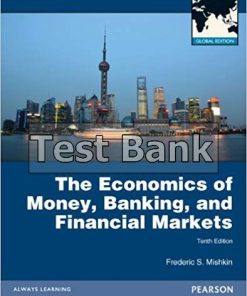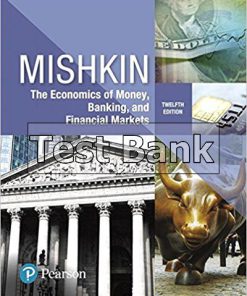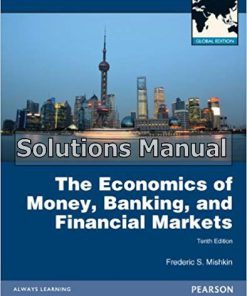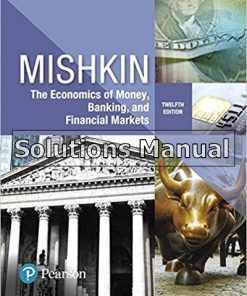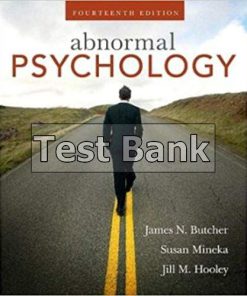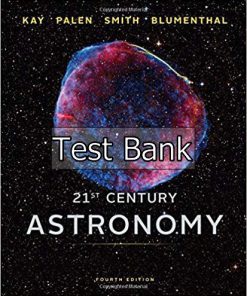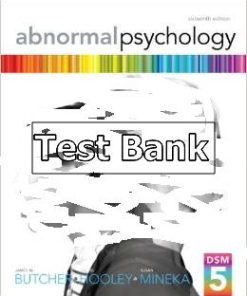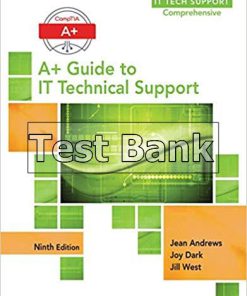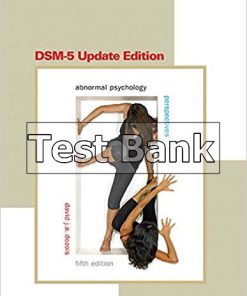Economics of Money Banking and Financial Markets 10th Edition Mishkin Test Bank
$26.50$50.00 (-47%)
Economics of Money Banking and Financial Markets 10th Edition Mishkin Test Bank.
You may also like
This is completed downloadable of Economics of Money Banking and Financial Markets 10th Edition Mishkin Test Bank
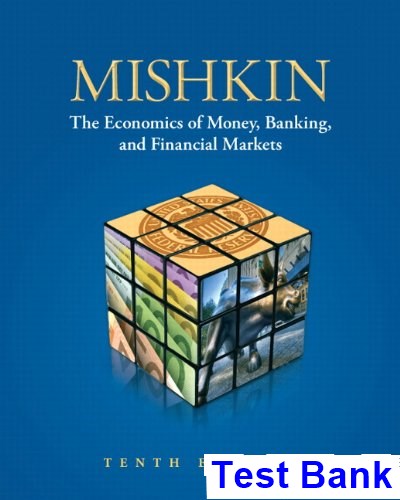
Product Details:
- ISBN-10 : 0132763648
- ISBN-13 : 978-0132763646
- Author:
Selling with study guide
Table of Content:
part I Introduction 1 Chapter 1 Why Study Money, Banking, and Financial Markets? 3 Preview 3 Why Study Financial Markets? 3 The Bond Market and Interest Rates 3 The Stock Market 5 The Foreign Exchange Market 5 Why Study Banking and Financial Institutions? 7 Structure of the Financial System 7 Banks and Other Financial Institutions 8 Financial Innovation 8 Why Study Money and Monetary Policy? 8 Money and Business Cycles 8 Money and Inflation 10 Money and Interest Rates 11 Conduct of Monetary Policy 12 Fiscal Policy and Monetary Policy 12 How We Will Study Money, Banking, and Financial Markets 13 Exploring the Web 14 Collecting and Graphing Data 15 Web Exercises 15 Concluding Remarks 16 Summary 17 Key Terms, Questions and Problems 18 Web Exercises and Web References 19 Appendix to Chapter 1 Defining Aggregate Output, Income, the Price Level, and the Inflation Rate 20 Aggregate Output and Income 20 Real Versus Nominal Magnitudes 20 Aggregate Price Level 21 Growth Rates and the Inflation Rate 22 Chapter 2 An Overview of the Financial System 23 Preview 23 Function of Financial Markets 23 Structure of Financial Markets 25 Debt and Equity Markets 25 Primary and Secondary Markets 26 Exchanges and Over-the-Counter Markets 27 Money and Capital Markets 27 Financial Markets Instruments 28 Money Maker Instruments 28 Following the Financial News Money Market Rates 30 Capital Market Instruments 31 Internationalization of Financial Markets 33 International Bond Market, Eurobonds, and Eurocurrencies 33 World Stock Markets 33 Following the Financial News Foreign Stock Market Indexes 34 Function of Financial Intermediaries 35 Transaction Costs 35 Box 1 Global: The Importance of Financial Intermediaries to Securities Markets: An International Comparison 36 Risk Sharing 36 Asymmetric Information: Adverse Selection and Moral Hazard 37 Types of Financial Intermediaries 39 Depository Institutions 39 Contractual Savings Institutions 40 Investment Intermediaries 42 Regulation of the Financial System 42 Increasing Information Available to Investors 44 Ensuring the Soundness of Financial Intermediaries 44 Financial Regulation Abroad 45 Summary 46 Key Terms, Questions and Problems 47 Web Exercises and Web References 48 Chapter 3 What Is Money? 49 Preview 49 Meaning of Money 49 Functions of Money 50 Medium of Exchange 50 Unit of Account 51 Store of Value 52 Evolution of the Payments System 53 Commodity Money 53 Fiat Money 53 Checks 53 Electronic Payment 54 E-Money 54 Box 1 E-Finance: Why Are Scandinavians So Far Ahead of Americans in Using Electronic Payments? 55 Box 2 E-Finance: Are We Headed for a Cashless Society? 56 Measuring Money 56 The Federal Reserve's Monetary Aggregates 56 Following the Financial News The Monetary Aggregates 58 Box 3 Where Are All the U. S. Dollars? 59 How Reliable Are the Money Data? 59 Summary 61 Key Terms, Questions and Problems 62 Web Exercises and Web References 63 part II Financial Markets 65 Chapter 4 Understanding Interest Rates 67 Preview 67 Measuring Interest Rates 67 Present Value 67 Application Simple Present Value 69 Application How Much Is That Jackpot Worth? 69 Four Types of Credit Market Instruments 70 Yield to Maturity 71 Application Yield to Maturity on a Simple Loan 71 Application Reading the Wall Street Journal: The Bond Page 72 Application Yeild to Maturity and the Yearly Payment on a Fixed-Payment Loan 73 Application Yeild to Maturity and the Bond Price for a Coupon Bond 74 Application Perpetuity 76 Box 1 Global: Negative T-Bill Rates? Japan Shows the Way 78 Yield on a Discount Basis 78 Application Reading the Wall Street Journal: The Bond Page 80 Following the Financial News Bond Prices and Interest Rates 81 The Distinction Between Interest Rates and Returns 82 Box 2 Helping Investors to Select Desired Interest-Rate Risk 85 Maturity and the Volatility of Bond Returns: Interest-Rate Risk 85 The Distinction Between Real and Nominal Interest Rates 87 Application Calculating Real Interest Rates 88 Box 3 With TIPS, Real Interest Rates Have Become Observable in the United States 90 Summary 90 Key Terms, Questions and Problems 91 Web Exercise sand Web References 92 Chapter 5 The Behavior of Interest Rates 93 Preview 93 Determinants of Asset Demand 93 Wealth 94 Expected Returns 94 Risk 95 Liquidity 95 Theory of Asset Demand 95 Supply and Demand in the Bond Market 95 Demand Curve 96 Supply Curve 98 Market Equilibrium 98 Supply and Demand Analysis 99 Changes in Equilibrium Interest Rates 99 Shifts in the Demand for Bonds 100 Shifts in the Supply of Bonds 103 Application Changes in the Interest Rate Due to Expected Inflation: The Fisher Effect 105 Application Changes in the Interest Rate Due to a Business Cycle Expansion 106 Application Explaining Low Japanese Interest Rates 109 Application Reading the Wall Street Journal "Credit Markets" Column 109 Following the Financial News The "Credit Markets" Column 110 Supply and Demand in the Market for Money: The Liquidity Preference Framework 111 Changes in Equilibrium Interest Rates in the Liquidity Reference Framework 113 Shifts in the Demand for Money 113 Shifts in the Supply of Money 114 Application Changes in the Equilibrium Interest Rate Due to Changes in Income, the Price Level, or the Money Supply 114 Changes in Income 114 Changes in the Price Level 114 Changes in the Money Supply 115 Application Money and Interest Rates 116 Does a Higher Rate of Growth of the Money Supply Lower Interest Rates? 118 Following the Financial News Forecasting Interest Rates 122 Summary 123 Key Terms, Questions and Problems 124 Web Exercises 125 Web References 126 Chapter 6 The Risk and Term Structure of Interest Rates 127 Preview 127 Risk Structure of Interest Rates 127 Default Risk 127 Application The Enron Bankruptcy and the Baa-Aaa Spread 131 Liquidity 131 Income Tax Considerations 132 Summary 133 Application Effects of the Bush Tax Cut on Bond Interest Rates 134 Term Structure of Interest Rates 134 Following the Financial News Yield Curves 136 Expectations Theory 136 Segmented Markets Theory 139 Liquidity Premium and Preferred Habitat Theories 140 Evidence on the Term Structure 143 Box 2 The Yield Curve as a Forecasting Tool for Inflation and the Business Cycle 144 Summary 144 Application Interpreting Yield Curves, 1980/2003 145 Summary 146 Key Terms, Questions and Problems 147 Web Exercises 148 Web References 149 Chapter 7 The Stock Market, the Theory of Rational Expectations, and the Efficient Market Hypothesis 151 Preview 151 Computing the Price of Common Stock 151 The One-Period Valuation Model 152 The Generalized Dividend Valuation Model 153 The Gordon Growth Model 153 How the Market Sets Security Prices 154 Application Monetary Policy and Stock Prices 155 Application The September 11 Terrorist Attacks, the Enron Scandal, and the Stock Market 156 The Theory of Rational Expectations 156 Formal Statement of the Theory 158 Rationale Behind the Theory 158 Implications of the Theory 159 The Efficient Markets Hypothesis: Rational Expectations in Financial Markets 160 Rationale Behind the Hypothesis 161 Stronger Version of the Efficient Market Hypothesis 162 Evidence on the Efficient Market Hypothesis 162 Evidence in Favor of Market Efficiency 162 Application Should Foreign Exchange Rates Follow a Random Walk? 165 Evidence Against Market Efficiency 165 Overview of the Evidence on the Efficient Market Hypothesis 168 Application Practical Guide to Investing in the Stock Market 168 How Valuable Are Published Reports by Investment Advisers? 168 Following the Financial News Stock Prices 169 Should You Be Skeptical of Hot Tips? 169 Box 1 Should You Hire an Ape as Your Investment Adviser? 170 Do Stock Prices Always Rise When There Is Good News? 170 Efficient Market Prescription for the Investor 171 Evidence on Rational Expectations in Other Markets 171 Application What Do the Black Monday Crash of 1987 and the Tech Crash of 2000 Tell Us About Rational Expectations and Efficient Markets? 172 Behavioral Finance 173 Summary 174 Key Terms, Questions and Problems 175 Web Exercises 176 WebReferences 177 part III Financial Institutions 179 Chapter 8 An Economic Analysis of Financial Structure 181 Preview 181 Basic Puzzles About Financial Structure Throughout the World 181 Transaction Costs 184 How Transaction Costs Influence Financial Structure 184 How Financial Intermediaries Reduce Transaction Costs 185 Asymmetric Information: Adverse Selection and Moral Hazard 186 The Lemons Problem: How Adverse Selection Influences Financial Structure 186 Lemons in the Stock and Bond Markets 187 Tools to Help Solve Adverse Selection Problems 188 Box 1 The Enron Implosion 189 How Moral Hazard Affects the Choice Between Debt and Equity Contracts 192 Moral Hazard in Equity Contracts: The Principal/Agent Problem 192 Tools to Help Solve the Principal/Agent Problem 193 How Moral Hazard Influences Financial Structure in Debt Markets 195 Tools to Help Solve Moral Hazard in Debt Contracts 195 Summary 197 Conflicts of Interest 198 Why Do We Care About Conflicts of Interest? 199 Why Do Conflicts of Interesst Arise? 199 Box 2 Conflicts of Interest The King, Queen, and the Jack of the Interest 200 What Has Been Done to Remedy Conflicts of Interest? 201 Box 3 Conflicts of Interest The Demise of Arthur Andersen 194 Application Financial Development and Economic Growth 203 Application Is China a Counter-Example to the Importance of Financial Developement? 204 Financial Crises and Aggregate Economic Activity 205 Factors Causing Financial Crises 206 Application Financial Crises in the United States 208 Box 4 Case Study of a Financial Crisis: The Great Depression 210 Application Financial Crises in Emerging-Market Countries: Mexico, 1994/1995; East Asia, 1997/1998; and Argentina, 2001/2002 211 Summary and Key Terms 215 Questions and Problems and Web Exercises 216 Web References 217 Chapter 9 Banking and the Management of Financial Institutions 219 Preview 219 The Bank Balance Sheet 219 Liabilities 219 Assets 222 Basic Banking 223 General Principles of Bank Management 226 Liquidity Management and the Role of Reserves 226 Asset Management 229 Liability Management 230 Capital Adequacy Management 231 Application Strategies for Managing Bank Capital 233 Application Did the Capital Crunch Cause a Credit Crunch in the Early 1990s? 234 Managing Credit Risk 234 Screening and Monitoring 235 Long-Term Customer Relationships 236 Loan Commitments 237 Collateral and Compensating Balances 237 Credit Rationing 238 Managing Interest-Rate Risk 238 Gap and Duration Analysis 239 Application Strategies for Managing Interest-Rate Risk 240 Off-Balance-Sheet Activities 241 Loan Sales 241 Generation of Fee Income 241 Trading Activities and Risk Management Techniques 242 Box 1 Global: Barings, Daiwa, Sumitomo, and Allied Irish: Rogue Traders and the Principal/Agent Problem 243 Summary and Key Terms 244 Questions and Problems 245 Web Exercises and Web References 246 Chapter 10 Banking Industry: Structure and Competition 247 Preview 247 Historical Development of the Banking System 247 Multiple Regulatory Agencies 249 Financial Innovation and the Evolution of the Banking Industry 250 Responses to Changes in Demand Conditions: Interest Rate Volatility 251 Responses to Changes in Supply Conditions: Information Technology 252 Box 1 E-Finance: Will "Clicks" Dominate "Bricks" in the Banking Industry? 254 Avoidance of Existing Regulations 255 Financial Innovation and the Decline of Traditional Banking 257 Structure of the U.S. Commercial Banking Industry 261 Restrictions on Branching 261 Response to Branching Restrictions 262 Bank Consolidation and Nationwide Banking 263 Box 2 E-Finance: Information Technology and Bank Consolidation 265 The Riegle-Neal Interstate Banking and Branching Efficiency Act of 1994 265 What Will the Structure of the U.S. Banking Industry Look Like in the Future? 266 Box 3 Global: Comparison of Banking Structure in the United States and Abroad 266 Are Bank Consolidation and Nationwide Banking Good Things? 267 Separation of the Banking and Other Financial Service Industries 268 Erosion of Glass-Steagall 268 The Gramm-Leach-Bliley Financial Services Modernization Act of 1999: Repeal of Glass-Steagall 268 Implications for Financial Consolidation 269 Separation of Banking and Other Financial Services Industries Throughout the World 269 Thrift Industry: Regulation and Structure 270 Savings and Loan Associations 270 Mutual Savings Banks 270 Credit Unions 271 International Banking 271 Eurodollar Market 272 Box 4 Global: Ironic Birth of the Eurodollar Market 273 Structure of U.S. Banking Overseas 273 Foreign Banks in the United States 273 Summary and Key Terms 275 Questions and Problems, and Web Exercises 276 Web References 277 Chapter 11 Economic Analysis of Banking Regulation 279 Preview 279 Asymmetric Information and Banking Regulation 279 Government Safety Net: Deposit Insurance and the FDIC 279 Box 1 Global: The Spread of Government Deposit Insurance Throughout the World: Is This a Good Thing? 281 Restrictions on Asset Holdings and Bank Capital Requirements 283 Bank Supervision: Chartering and Examination 284 Box 2 Global: Basel 2: Is It Unworkable? 285 Assessment of Risk Management 286 Disclosure Requirements 287 Consumer Protection 288 Restrictions on Competition 288 Box 3 E-Finance: Electronic Banking: New Challenges for Bank Regulation 289 International Banking Regulation 291 Problems in Regulating International Banking 291 Summary 291 The 1980s U.S. Savings and Loan and Banking Crisis: Why? 293 Early Stages of the Crisis 293 Later Stages of the Crisis: Regulatory Forbearance 294 Competitive Equality in Banking Act of 1987 295 Political Economy of the Savings and Loan Crisis 295 The Principal/Agent Problem for Regulators and Politicians 296 FYI The Principal-Agent Problem in Action: Charles Keating and the Lincoln Savings and Loan Scandal 297 Savings and Loan Bailout: The Financial Institutions Reform, Recovery, and Enforcement Act of 1989 298 Federal Deposit Insurance Corporation Improvement Act of 1991 299 Banking Crises Throughout the World 300 Scandinavia 301 Latin America 302 Russia and Eastern Europe 302 Japan 303 China 304 East Asia 305 "Døjø Vu All Over Again" 305 Summary 305 Key Terms, Questions and Problems 306 Web Exercises and Web References 307 Part IV Central Banking and the Conduct of Monetary Policy 309 Chapter 12 Structure of Central Banks and the Federal Reserve System 311 Preview 311 Origins of the Federal Reserve Systems 311 Box1 Inside the Fed The political Genius of the Founders of the Federal Reserve System 312 Structure of the Federal Reserve System 312 Federal Reserve Banks 313 Box2 Inside the Fed The special Role of the Federal Reserve Bank of New York 315 Member Banks 316 Board of Governors of the Federal Reserve System 316 Federal Open market Committee (FOMC) 317 Box3 Inside the Fed The Role of the Research Staff 318 The FOMC Meeting 319 Box4 Inside the Fed Green, Blue, and Beige: What Do These Colors Mean at the Fed? 320 Why the Chairman of the Board of Governors Really Runs the Show 320 How Independent is the Fed? 321 Structure and Independence of the European Central Bank 322 Differences Between the European System of Central Banks and the Federal Reserve System 323 Governing Council 323 How Independent Is the ECB? 324 Structure and Independence of other Foreign Central Banks 325 Bank of Canada 325 Bank of England 325 Bank of Japan 326 The Trend Toward Greater Independence 326 Explaining Central Bank Behavior 326 Box5 Inside the Fed Federal Reserve Transparency 327 Should the Fed be Independent? 328 The Case for Independence 328 The Case Against Independence 329 Central Bank Independence and Macroeconomic Performance Throughout The World 330 Summary 330 Key Terms 331 Questions and Problems 331 Web Exercises and Web References 332 Chapter 13 Multiple Deposit Creation and the Money Supply Process 333 Preview 333 Four Players in the Money Supply Process 333 The Fed's Balance Sheet 334 Liabilities 334 Control of the Monetary Base 335 Federal Reserve Open Market Operations 336 Shifts from Deposits into Currency 339 Discount Loans 340 Other Factors That Affect the Monetary base 341 Overview of the Fed's Ability to Control the Monetary Base 341 Multiple Deposit Creation: A Simple Model 341 Deposit Creation: The Single Bank 41 Deposit Creation: The Banking System 343 Deriving the Formula for Multiple Deposit Creation 345 Critique of the Simple Model 347 Summary 347 Key Terms and Questions and Problems 348 Web Exercises and Web References 349 Chapter 14 Determinants of the Money Supply 351 Preview 351 The Money Supply Model and the Money Multiplier 352 Deriving the Money Multiplier 352 Intuition Behind the Money Multiplier 354 Factors that Determine the Money Multiplier 355 Changes in the Required Reserve Ratio r 355 FYI The Declining Importance of Reserve Requirements 356 Changes in the Currency Ratio c 357 Changes in the Excess Reserves Ratio e 357 Additional Factors That Determine the Money Supply 359 Changes in the Nonborrowed Monetary Base MBn 360 Changes in the Discount Loans DL from the Fed 360 Overview of the Money Supply Process 360 Application Explaining Movements in the Money Supply, 1980/2005 362 Application The Great Depression Bank Panics, 1930/1933 364 Summary, Key Terms, Questions and Problems 368 Web Exercises and References 369 Appendix to Chapter 14 The M2 Money Multiplier 370 Factors that Determine the M2 Money Multiplier 371 Response to Changes in t and mm 371 Chapter 15 Tools of Monetary Policy 373 Preview 373 The Market for Reserves and the Federal Funds Rate 373 Supply and Demand in the Market for Reserves 374 How Changes in the Tools of Monetary Policy Affect the Federal Funds Rate 375 Open Market Operations 378 A Day at the Trading Desk 378 Advantages of Open Market Operations 380 Discount Policy 380 Operation of the Discount Window 381 Lender of Last Resort 381 Advantages and Disadvantages of Discount Policy 383 Reserve Requirements 383 Box 1 Inside the Fed: Using Discount Policy 384 Disadvantages of Reserve Requirements 385 Application Why Have Reserve Requirements Been Declining Worldwide? 385 Application The Channel/Corridor System for Setting Interest Rates in Other Countries 386 Monetary Policy Tools of the European Central Bank 388 Open Market Operations 388 Reserve Requirements 389 Summary 389 Key Terms and Questions and Problems 390 Web Exercises and Web References 391 Chapter 16 What Should Central Banks Do? Monetary Policy Goals, Strategy, and Tactics 393 Preview 393 The Price Stability Goal and the Nominal Anchor 393 The Role of a Nominal Anchor 394 The Time-Inconsistency Problem 394 Other Goals of Monetary Policy 395 High Employment 395 Economic Growth 396 Stability of Financial Markets 396 Interest-Rate Stability 396 Stability in Foreign Exchange Markets 396 Should Price Stability be the Primary Goal of Monetary Policy? 397 Hierarchical Versus Dual Mandates 397 Price Stability as the Primary, Long-Run Goal of Monetary Policy 398 Monetary Targeting 398 Monetary Targeting in the United States, Japan, and Germany 398 Box1 Global: The European Central Bank's Monetary Policy Strategy 401 Advantages of Monetary Targeting 402 Disadvantages of Monetary Targeting 402 Inflation Targeting 402 Inflation Targeting in New Zealand, Canada, and the United Kingdom 403 Advantages of Inflation Targeting 405 Disadvantages of Inflation Targeting 406 Monetary Policy with an Implicit Nominal Anchor 408 Advantages of the Fed's Approach 409 Disadvantages of the Fed's Approach 409 Box2 Inside the Fed The New Fed Chairman and Inflation Targeting 410 Tactics: Choosing the Policy Instrument 412 The Taylor Rule, NAIRU, and the Phillips Curve 414 Box3 Inside the Fed Fed Watchers 416 Summary 417 Key Terms, Questions and Problems 418 Web Exercises and Web References 419 Appendix to Chapter16 Fed Policy Procedures: Historical Perspective 420 The Early Years: Discount Policy as the Primary Tool 420 Discovery of Open Market Operations 421 The Great Depression 421 Box4 Inside the Fed Bank Panics of 1930-1933: Why Did the Fed Let Them Happen? 422 Reserve Requirements as a Policy Tool 422 War Finance and the Pegging of Interest Rates: 1942/1951 423 Targeting Money Market Conditions: The 1950s and 1960s 423 Targeting Monetary Aggregates: The 1970s 424 New Fed Operating Procedures: October 1979/October 1982 425 De-Emphasis of Monetary Aggregates: October 1982/Early 1990s 426 Federal Funds Targeting Again: Early 1990s and Beyond 427 International Considerations 428 Box5 Global International Policy Coordination: The Plaza Agreement and the Louvre Accord 428 Part V International Finance and Monetary Policy 429 Chapter 17 The Foreign Exchange Market 431 Preview 431 Foreign Exchange Market 431 What Are Foreign Exchange Rates? 432 Box1 Following the Financial News Foreign Exchange Rates 433 Why Are Exchange Rates Important? 433 How Is Foreign Exchange Traded? 433 Exchange Rates in the Long Run 434 Law of One Price 434 Theory of Purchasing Power Parity 434 Why the Theory of Purchasing Power Parity Cannot Fully Explain Exchange Rates 436 Factors That Affect Rates in the Long Run 437 Exchange Rates in the Short Run 438 Comparing Expected Returns on Domestic and Foreign Deposits 439 Interest Parity Condition 441 Demand Curve for Domestic Assets 442 Supply Curve for Domestic Assets 443 Equilibrium in the Foreign Exchange Market 443 Explaining Changes in Exchange Rates 444 Shifts in the Expected-Return Schedule for Foreign Deposits 444 Application Changes in the Equilibrium Exchange Rate: Two Examples 447 Changes in Interest Rates 447 Changes in the Money Supply 449 Exchange Rate Overshooting 450 Application Why Are Exchange Rates So Volatile? 451 Application The Dollar and Interest Rates, 1973/2005 452 Application The Euro's First Four Years 453 Application Reading the Wall Street Journal: The "Currency Trading" Column 453 Box 2 Following the Financial News The "Currency Trading" Column 454 Summary and Key Terms 455 Questions and Problems, and Web Exercises 456 Web References 457 Chapter 18 The International Financial System 459 Preview 459 Intervention in the Foreign Exchange Market 459 Foreign Exchange Intervention and the Money Supply 459 Box 1 Inside the Fed: A Day at the Federal Reserve Bank of New York's Foreign Exchange Desk 460 Unsterilized Intervention 462 Sterilized Intervention 463 Balance of Payments 464 Box1 Global Why the Large U. S. Current Account Deficit Worries Economists 465 Exchange Rate Regimes in the International Financial System 465 Gold Standard 466 Bretton Woods System 466 Box 2 Global: The Euro's Challenge to the Dollar 467 How the Fixed Rate Regime Works 467 Application How Did China Accumulate Nearly $1 Trillion of International Reserves? 470 Managed Float 471 European Monetary System(EMS) 472 Application Recent Foreign Exchange Crises of September 1992 472 Application Recent Foreign Exchange Crises in Emerging Market Countries: Mexico 1994, East Asia 1997, Brazil 1999, and Argentina 2002 474 Capital Controls 475 Controls on Capital Outflows 475 Controls on Capital Inflows 476 The Role of the IMF 477 How Should the IMF Operate? 478 International Considerations and Monetary Policy 479 Should the IMF Be an International Lender of Last Resort? 480 Direct Effects of the Foreign Exchange Market on the Money Supply 479 Balance-of-Payments Considerations 480 Exchange Rate Considerations 480 To Peg or Not to Peg: Exchange-Rate Targeting as an alternative Monetary Policy Strategy 481 Advantages of Exchange-Rate Targeting 481 Disadvantages of Exchange-Rate Targeting 482 When is Exchange-Rate Targeting Desirable for Industrialized Countries 484 When is Exchange-Rate Targeting Desiravle for Emerging Market Countries? 484 Currency Boards 485 Dollarization 485 Box3 Global Argentina's Currency Board 486 Summary 487 Key Terms, Questions and Problems 488 Web Exercises and Web References 489 Part VI Chapter 19 Monetary Theory 491 The Demand for Money 493 Preview 493 Quantity Theory of Money 493 Velocity of Money and Equation of Exchange 494 Quantity Theory 495 Quantity Theory of Money Demand 495 Is Velocity a Constant? 496 Keynes's Liquidity Preference Theory 497 Transactions Motive 497 Precautionary Motive 498 Speculative 498 Putting the Three Motives Together 499 Further Developments in the Keynesian Approach 501 Transactions Demand 501 Precautionary Demand 503 Speculative Demand 504 Friedman's Modern Quantity Theory of Money 505 Distinguishing Between The Friedman and Keynesian Theories 507 Empirical Evidence on the Demand for Money 509 Interest Rates and Money Demand 509 Stability of Money Demand 510 Summary 510 Key Terms, Questions and Problems 511 Web Exercises and Web References 512 Chapter 20 The ISLM Model 513 Preview 513 Determination of Aggregate Output 513 Consumer Expenditure and the Consumption Function 514 Investment Spending 526 Box1 FYI Meaning of the Word Investment 517 Equilibrium and the Keynesian Gross Diagram 517 Expenditure Multiplier 519 Application The Collapse of Investment Spending and the Great Depression 521 Government's Role 522 Role of International Trade 524 Summary of the Determinants of Aggregate Output 525 The ISLM Model 528 Equilibrium in the Goods Market: The IS Curve 528 Equilibrium in the Market for Money: The LM Curve 531 ISLM Approach to Aggregate output and Interest Rates 533 Summary and Key Terms 535 Questions and Problems and Web Exercises 536 Web References 537 Chapter 21 Monetary and Fiscal Policy in the ISLM Model 539 Preview 539 Factors That Cause The IS Curve to Shift 539 Factors That Cause The LM Curve to Shift 542 Changes in Equilibrium Level of the Interest Rate and Aggregate Output 544 Response to a Change in Monetary Policy 544 Response to a Change in Fiscal Policy 545 Effectiveness of Monetary Versus Fiscal Policy 546 Monetary Policy Versus Fiscal Policy: The Case of Complete Crowding Out 546 Application Targeting Money Supply Versus Interest Rates 549 ISLM Model in the Long Run 552 ISLM Model and the Aggregate Demand Curve 554 Deriving the Aggregate Demand Curve 555 Factors That Cause the Aggregate demand Curve to Shift 556 Summary and Key Terms 558 Questions and Problems, and Web Exercises 559 Web References 560 Chapter 22 Aggregate Demand and Supply Analysis 561 Preview 561 Aggregate Demand 561 Quantity Theory of Money Approach to Aggregate Demand 561 Box1 Following the Financial News Aggregate Output, Unemployment, and the Price Level Deriving Aggregate Demand from the Behavior of It's Component Parts 564 Aggregate Supply 565 Long-Run Aggregate Supply Curve 567 Short-Run Aggregate Supply Curve 567 Shifts in the Short-Run Aggregate Supply Curve 568 Factors that Shift the Short-Run Aggregate Supply Curve 569 Equilibrium in Aggregate Supply and Demand Analysis 570 Equilibrium in the Short Run 570 Equilibrium in the long Run 571 Changes in Equilibrium Caused by Aggregate Demand Shocks 574 Changes in Equilibrium Caused by Aggregate Supply Shocks 575 Shifts in the Long-Run Aggregate Supply Curve: Real Business Cycle Theory and Hysteresis 575 Conclusions 577 Application Explaining Past Business Cycle Episodes 577 Vietnam War Buildup, 1964-1970 577 Negative Supply Shocks, 1973/1975 and 1978/1980 578 Favorable Supply Shocks, 1995/1999 579 Negative Demand Shocks, 2001/2004 579 Summary and Key Terms 580 Questions and Problems 581 Web Exercises and Web References 582 Chapter 23 Transmission Mechanisms of Monetary Policy: The Evidence 583 Preview 583 Framework for Evaluation Empirical Evidence 583 Structural Model Evidence 584 Reduced-Form Evidence 584 Advantages and Disadvantages of Structural Model Evidence 585 Advantages and Disadvantages of Reduced-Form Evidence 585 Box1 FYI Perils of Reverse Causation: A Russian Folk Tale 586 Conclusion 586 Box2 FYI Perils of Ignoring an Outside Driving Factor: How to Lose a Presidential Election 587 Application The Debate on the Importance of Monetary Policy to Economic Fluctuations 587 Early Keynesian Evidence on the Importance of Money 587 Objections to Early Keynesian Evidence 588 Early Monetarist Evidence on the Importance of Money 591 Overview of the Monetarist Evidence 595 Box3 FYI Real Business Cycle Theory and the Debate on Money and Economic Activity 596 Transmission Mechanisms of Monetary Policy 596 Traditional Interest-Rate Channels 597 Other Asset Price Channels 598 Credit view 601 Box4 FYI Consumers' Balance Sheets and the Great Depression 604 Why Are Credit Channels Likely to be Important 605 Application Corporate Scandals and the Slow Recovery from the March 2001 Recession 605 Lessons for Monetary Policy 606 Application Applying the Monetary Policy Lessons to Japan 607 Summary 608 Key Terms and Questions and Problems 609 Web Exercises 610 Web References 611 Chapter 24 Money and Inflation 613 Preview 613 Money and Inflation: Evidence 613 German Huperinflation, 1921/1923 614 Recent Episodes of Raid Inflation 614 Meaning of Inflation 615 Views of Inflation 616 How money Growth Produces Inflation 616 Can Other Factors Besides Money Growth Produce a Sustained Inflation? 617 Summary 619 Origins of Inflationary Monetary Policy 620 High Employment Targets and Inflation 620 Budget Deficits and Inflation 623 Application Explaining the Rise in U. S. Inflation, 1960/1980 627 Activist/NonActivist Policy Debate 630 Responses to High Unemployment 630 Activist and Nonactivist Positions 632 Expectations and the Activist/Nonactivist Debate 632 Activist Versus Nonactivist: Conclusions 634 Application Importance of Credibility to Volcker's Victory over Inflation 634 Summary and Key Terms 635 Questions and Problems and Web Exercises 636 Web References 637 Chapter 25 Rational Expectations: Implications for Policy 639 Preview 639 The Lucas Critique of Policy Evaluation 640 Econometric Policy Evaluation 640 Example: The Term Structure of Interest Rates 640 New Classical Macroeconomic Model 641 Effects of Unanticipated and Anticipated Policy 642 Box 1 FYI Proof of the Policy Ineffectiveness Proposition 644 Can an Expansionary Policy Lead to a Decline in Aggregate Output? 644 Implications for Policymakers 645 New Keynesian Model 646 Effects of Unanticipated and Anticipated Policy 647 Implications for Policymakers 647 Comparison of the Two New Models with the Traditional Model 649 Short-Run Output and Price Responses 649 Stabilization Policy 652 Anti-inflation Policies 652 Credibility in Fighting Inflation 655 Box 2 Global: Ending the Bolivian Hyperinflation: Case Study of a Successful Anti-inflation Program 656 Application Credibility and the Reagan Budget Deficits 656 Impact of the Rational Expectations Revolution 656 Summary 658 Key Terms, Questions and Problems 659 Web Exercises and Web References 660 Chapter 26 Transmission Mechanisms of Monetary Policy: The Evidence 603 Preview 603 Framework for Evaluating Empirical Evidence 603 Structural Model Evidence 604 Reduced-Form Evidence 604 Advantages and Disadvantages of Structural Model Evidence 605 Advantages and Disadvantages of Reduced-Form Evidence 606 Box 1 Perils of Reverse Causation: A Russian Folk Tale 606 Box 2 Perils of Ignoring an Outside Driving Factor: How to Lose a Presidential Election 607 Conclusions 607 Early Keynesian Evidence on the Importance of Money 607 Objections to Early Keynesian Evidence 608 Early Monetarist Evidence on the Importance of Money 611 Timing Evidence 611 Statistical Evidence 613 Historical Evidence 615 Overview of the Monetarist Evidence 615 Box 3 Real Business Cycle Theory and the Debate on Money and Economic Activity 616 Transmission Mechanisms of Monetary Policy 616 Traditional Interest-Rate Channels 617 Other Asset Price Channels 618 Credit View 621 Box 4 Consumers' Balance Sheets and the Great Depression 624 Why Are Credit Channels Likely to Be Important? 625 Application Corporate Scandals and the Slow Recovery from the March 2001 Recession 625 Lessons for Monetary Policy 626 Application Applying the Monetary Policy Lessons to Japan 628 Summary, Key Terms, Questions and Problems, and Web Exercises 629 Chapter 27 Money and Inflation 632 Preview 632 Money and Inflation: Evidence 632 German Hyperinflation, 1921/1923 633 Recent Episodes of Rapid Inflation 633 Meaning of Inflation 634 Views of Inflation 635 Monetarist View 635 Keynesian View 636 Summary 638 Origins of Inflationary Monetary Policy 638 High Employment Targets and Inflation 639 Budget Deficits and Inflation 643 Application Explaining the Rise in U.S. Inflation, 1960/1980 646 Activist/Nonactivist Policy Debate 650 Responses to High Unemployment 650 Activist and Nonactivist Positions 651 Expectations and the Activist/Nonactivist Debate 652 Box 1 Perils of Accommodating Policy: The Terrorism Dilemma 654 Rules Versus Discretion: Conclusions 654 Application Importance of Credibility to Volcker's Victory over Inflation 655 Summary, Key Terms, Questions and Problems, and Web Exercises 655 Chapter 28 Glossary G-1 Answers to Selected Questions and Problems A-1 Credits C-1 Index I-1
People Also Search:
economics of money banking and financial markets mishkin
economics of money banking and financial markets 10th edition mishkin
economics of money banking and financial markets 10th edition
economics of money banking and financial markets 10th edition testbank download pdf
economics of money banking and financial markets 10th edition download scribd

